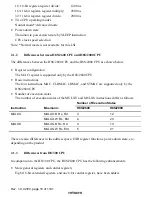
Rev. 1.0, 02/00, page 20 of 1141
2.2
CPU Operating Modes
The H8S/2000 CPU has two operating modes: normal and advanced. Normal mode supports a
maximum 64-kbyte address space. Advanced mode supports a maximum 16-Mbyte total address
space (architecturally the maximum total address space is 4 Gbytes, with a maximum of 16
Mbytes for the program area and a maximum of 4 Gbytes for the data area).
The mode is selected by the mode pins of the microcontroller.
CPU operating mode
Normal mode*
Advanced mode
Maximum 64 kbytes for program
and data areas combined
Maximum 16 Mbytes for program
and data areas combined
Note: * Normal mode is not available for this LSI.
Figure 2.1 CPU Operating Modes
(1) Normal Mode (Not available for this LSI)
The exception vector table and stack have the same structure as in the H8/300 CPU.
(a) Address Space
A maximum address space of 64 kbytes can be accessed.
(b) Extended Registers (En)
The extended registers (E0 to E7) can be used as 16-bit registers, or as the upper 16-bit
segments of 32-bit registers. When En is used as a 16-bit register it can contain any value,
even when the corresponding general register (Rn) is used as an address register. If the
general register is referenced in the register indirect addressing mode with pre-decrement
(@-Rn) or post-increment (@Rn+) and a carry or borrow occurs, however, the value in the
corresponding extended register (En) will be affected.
(c) Instruction Set
All instructions and addressing modes can be used. Only the lower 16 bits of effective
addresses (EA) are valid.
















































